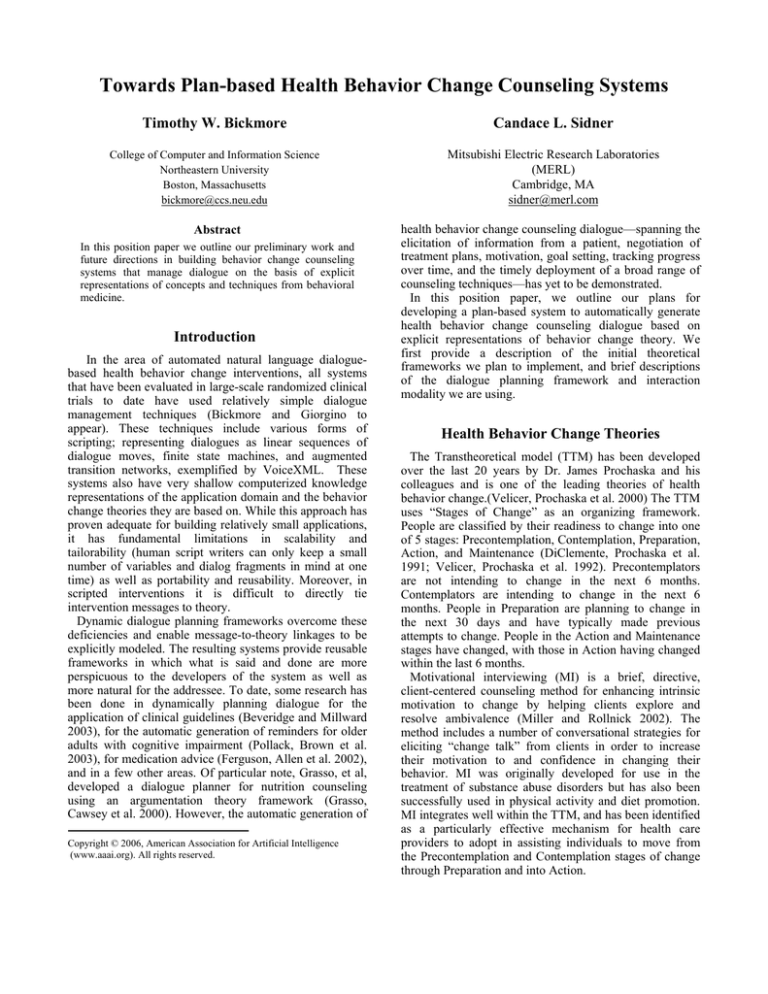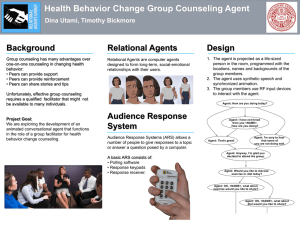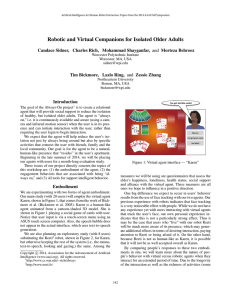
Towards Plan-based Health Behavior Change Counseling Systems
Timothy W. Bickmore
Candace L. Sidner
College of Computer and Information Science
Northeastern University
Boston, Massachusetts
bickmore@ccs.neu.edu
Mitsubishi Electric Research Laboratories
(MERL)
Cambridge, MA
sidner@merl.com
Abstract
health behavior change counseling dialogue—spanning the
elicitation of information from a patient, negotiation of
treatment plans, motivation, goal setting, tracking progress
over time, and the timely deployment of a broad range of
counseling techniques—has yet to be demonstrated.
In this position paper, we outline our plans for
developing a plan-based system to automatically generate
health behavior change counseling dialogue based on
explicit representations of behavior change theory. We
first provide a description of the initial theoretical
frameworks we plan to implement, and brief descriptions
of the dialogue planning framework and interaction
modality we are using.
In this position paper we outline our preliminary work and
future directions in building behavior change counseling
systems that manage dialogue on the basis of explicit
representations of concepts and techniques from behavioral
medicine.
Introduction1
In the area of automated natural language dialoguebased health behavior change interventions, all systems
that have been evaluated in large-scale randomized clinical
trials to date have used relatively simple dialogue
management techniques (Bickmore and Giorgino to
appear). These techniques include various forms of
scripting; representing dialogues as linear sequences of
dialogue moves, finite state machines, and augmented
transition networks, exemplified by VoiceXML. These
systems also have very shallow computerized knowledge
representations of the application domain and the behavior
change theories they are based on. While this approach has
proven adequate for building relatively small applications,
it has fundamental limitations in scalability and
tailorability (human script writers can only keep a small
number of variables and dialog fragments in mind at one
time) as well as portability and reusability. Moreover, in
scripted interventions it is difficult to directly tie
intervention messages to theory.
Dynamic dialogue planning frameworks overcome these
deficiencies and enable message-to-theory linkages to be
explicitly modeled. The resulting systems provide reusable
frameworks in which what is said and done are more
perspicuous to the developers of the system as well as
more natural for the addressee. To date, some research has
been done in dynamically planning dialogue for the
application of clinical guidelines (Beveridge and Millward
2003), for the automatic generation of reminders for older
adults with cognitive impairment (Pollack, Brown et al.
2003), for medication advice (Ferguson, Allen et al. 2002),
and in a few other areas. Of particular note, Grasso, et al,
developed a dialogue planner for nutrition counseling
using an argumentation theory framework (Grasso,
Cawsey et al. 2000). However, the automatic generation of
Copyright © 2006, American Association for Artificial Intelligence
(www.aaai.org). All rights reserved.
Health Behavior Change Theories
The Transtheoretical model (TTM) has been developed
over the last 20 years by Dr. James Prochaska and his
colleagues and is one of the leading theories of health
behavior change.(Velicer, Prochaska et al. 2000) The TTM
uses “Stages of Change” as an organizing framework.
People are classified by their readiness to change into one
of 5 stages: Precontemplation, Contemplation, Preparation,
Action, and Maintenance (DiClemente, Prochaska et al.
1991; Velicer, Prochaska et al. 1992). Precontemplators
are not intending to change in the next 6 months.
Contemplators are intending to change in the next 6
months. People in Preparation are planning to change in
the next 30 days and have typically made previous
attempts to change. People in the Action and Maintenance
stages have changed, with those in Action having changed
within the last 6 months.
Motivational interviewing (MI) is a brief, directive,
client-centered counseling method for enhancing intrinsic
motivation to change by helping clients explore and
resolve ambivalence (Miller and Rollnick 2002). The
method includes a number of conversational strategies for
eliciting “change talk” from clients in order to increase
their motivation to and confidence in changing their
behavior. MI was originally developed for use in the
treatment of substance abuse disorders but has also been
successfully used in physical activity and diet promotion.
MI integrates well within the TTM, and has been identified
as a particularly effective mechanism for health care
providers to adopt in assisting individuals to move from
the Precontemplation and Contemplation stages of change
through Preparation and into Action.
In our work we are developing a counseling system
based on TTM- and MI-based health behavior change
concepts and techniques as applied to physical activity
promotion. Participation in moderate amounts of physical
activity has important health benefits, including beneficial
effects on risk factors for disease, disability, and
mortality,(LaPorte, Adams et al. 1984; Stewart and Haskell
1993; Young, Haskell et al. 1993; Bouchard and Stephens
1994; Services 1996) yet a substantial proportion of the
U.S. adult population remain underactive or
sedentary.(Services 1996) In addition, we have experience
developing and evaluating script-based physical activity
promotion systems (Bickmore, Gruber et al. 2005;
Bickmore, Caruso et al. to appear). We are modeling
constructs specific to TTM and MI and how these relate to
physical activity-specific interventions, focused on
Precontemplators and Contemplators, but also including
some concepts and counseling techniques for patients who
have moved on to Action (e.g., goal setting and positive
reinforcement).
COLLAGEN
COLLAGEN is an application-independent dialog
planning framework developed over the last ten years at
MERL (Rich and Sidner 1998). COLLAGEN is based on
the SharedPlan theory of Grosz and Sidner (Grosz and
Sidner 1986; Grosz and Sidner 1990), Grosz and Kraus
(Grosz and Kraus 1993; Grosz and Kraus 1996), and
Lochbaum (Lochbaum 1998), which provides a wellspecified computational theory that has been empirically
validated across a range of human domains. The theory, in
turn, is based on the notion of collaboration, in which two
or more participants coordinate their actions toward
achieving shared goals. Dialogue, from this perspective, is
fundamentally a collaboration between two people, who
must coordinate the start, end and maintenance of the
interaction, negotiate topics, turn taking, and other
conversational actions (Clark 1996). Collaboration is also
an especially appropriate theoretical foundation for
medical and therapeutic dialog given the recent focus on
patient-centered medicine (Bensing 2000), therapeutic
alliance (Gelso and Hayes 1998), and shared decision
making between physicians and patients.
outcomes, and increased patient satisfaction (Roter and
Hall 1993). In psychotherapy, the positive effect of a good
therapist-patient relationship on outcomes has been
demonstrated in many studies, and has even been
hypothesized to be the common factor underlying the
many diverse approaches to psychotherapy that seem to
provide approximately equivalent results (Gelso and Hayes
1998).
These results indicate that effective automated health
behavior change interventions must not only be able to
deploy appropriate intervention messages at the
appropriate time, but must also address social and
relational issues in their communication with users. In
scripted dialog systems, human script writers tacitly
address these issues in the scripts they create. However, if
computers are to take over more of the dialogue authoring
task, the rules underlying these relational factors must be
explicitly codified into the system. Relational agents are
computer agents that are designed to do this, and use these
techniques to maintain long-term relationships with users
over repeated interactions (Bickmore and Picard 2005),
essential for maximizing the effectiveness of behavior
change interventions that typically last months or
sometimes years in duration. Although relational agents
could be constructed using a wide range of media,
embodied conversational agents (Cassell, Sullivan et al.
2000)—those which simulate face-to-face conversation
through the use of computer animated characters that use
hand gesture, gaze, facial display and other nonverbal
modalities—are particularly effective given that face-toface conversation is the primary modality used to build
human relationships (Duck 1995), and that many of the
relational strategies that humans use within conversation
are nonverbal (Andersen and Guerrero 1998). Embodied
agents also provide additional channels that can be used to
communicate emotional state (e.g., through facial display),
Relational Agents
The importance of good communication and quality
relationships between health care providers and their
patients is now widely recognized as a key factor in
improving not only patient satisfaction, but treatment
outcomes across a wide range of health care disciplines.
The use of specific communication skills by physicians—
including strategies for conducting patient-centered
interviews
and
relationship
development
and
maintenance—has been associated with improved
adherence to treatment regimens, improved physiological
Figure 1. Relational Exercise Advisor Agent
EvaluateExercise
ShowGraph
DiscussPreviousDay
EvaluateExercise
Opening
1
DiscussPreviousDay
2
ShowGraph
DiscussNextDay
DiscussGraph
3
Focus Stack
Plan Tree
Closing
Interacting about exercise.
1 Done opening interaction.
Discussing previous day.
2 Done client identifying steps walked yesterday as 1000.
Coach says “How many steps did you walk yesterday?”
Client says “1000.”
Coach showing graph for the week.
3 Coach says “Here’s how you’ve done this week.”
Next expecting coach to show graph for the week.
Expecting to discuss graph.
Expecting to discuss next day.
Expecting to close interaction.
Figure 2. State and Segmented Interaction History for PA Example
which many researchers have cited as an important but
understudied aspect of argumentation systems.
A relational agent that plays the role of an exercise
advisor has been developed that is designed to conduct
daily dialogues with users to help them increase their
levels of physical activity (see Figure 1). This agent has
been successfully evaluated in two randomized clinical
trials involving college students (Bickmore, Gruber et al.
2005) and geriatrics patients (Bickmore, Caruso et al. to
appear).
Current Status
We have implemented an initial prototype, Action-stage,
physical activity promotion counseling system in
COLLAGEN. A snapshot of the dialogue state during a
consultation is shown in Figure 2. This system conducts a
brief counseling session by first engaging in a greeting
exchange (Opening), followed by a discussion of the
client’s exercise behavior on the previous day
(DiscussPreviousDay), followed by a goal-setting dialogue
for the following day (DiscussNextDay), and finally a
farewell exchange (Closing). Exercise behavior is
determined by simply asking the client how many steps
they walked, and feedback is given based on whether the
steps actually walked is greater or less than a previouslyestablished goal. If the goal is met, positive feedback is
provided (“You’ve met your goal for yesterday.”),
otherwise encouragement is provided (“Don’t give up!”),
and, in both cases, a tip is given (e.g., “You'll find it easier
to meet your goal if you walk at the same time each day.”).
The goal-setting dialogue consists of the agent reminding
the client of what their long-term goals are and prompting
them to set a goal based on their current level of activity
and their long-term goal. The dialogue is structured
hierarchically on the basis of a decomposition of task goals
shared between the agent and client. For example, the
DiscussPreviousDay goal is partially satisfied by
presenting and discussing a self-monitoring graph
depicting exercise progress over time (ShowGraph,
DiscussGraph).
COLLAGEN's discourse state consists of a stack of
goals, called the focus stack, and a plan tree for each goal
on the stack. The top goal on the focus stack is the
“current purpose (goal)” of the dialog. A plan tree in
COLLAGEN is an (incomplete) encoding of a partial
SharedPlan between the user and the agent (Grosz and
Sidner 1990). For example, Figure 2 shows the focus
stack and plan tree immediately following the discourse
events numbered 1—3 on the right side of the figure.
The annotated, indented execution trace on the right side
of Figure 2, called a segmented interaction history, is a
compact textual representation of the past, present, and
expected future states of the dialog. The numbered lines in
a segmented interaction history are simply a log of the
agent's and user's utterances and primitive actions. The
italic lines and indentation reflect COLLAGEN's
interpretation of these events. Specifically, each level of
indentation defines a segment whose purpose is specified
by the italicized line that precedes it. For example, the
purpose of the toplevel segment in Figure 2 is Interacting
about exercise. Unachieved purposes that are currently on
the focus stack are annotated using the present tense, such
as discussing, whereas completed purposes use the past
tense, such as done.
Finally, the italic lines at the end of each segment, which
include the keyword expecting, indicate the steps in the
current plan for the segment's purpose which have not yet
been executed. The steps which are ”live” with respect to
the plan's ordering constraints and preconditions have the
added keyword next.
Conclusion
Our general plans are to augment COLLAGEN with an
ontology of concepts from health behavior change, ranging
from theoretical constructs (e.g., stage of change) to
specific counseling techniques (e.g., taken from
motivational interviewing). We also plan to use the
FitTrack relational agent as a front end for the system so
that we can explore the generation of appropriate relational
behavior
(e.g.,
social
dialogue,
meta-relational
communication, etc.) from first principles as well.
Currently, we plan to determine most information about
the client’s intention to change and level of motivation by
direct questioning, either using questions from a validated
instrument (e.g., (Marcus, Selby et al. 1992)) or techniques
from motivational interviewing (Miller and Rollnick
2002). Inferring this information from less structured
dialogue (as in (de Rosis, Novielli et al. to appear)) is an
interesting direction of research, but not within our current
plans.
Our objective is to demonstrate that health behavior
change dialogue can be generated from deep, ontology-
based models of collaboration and behavior change theory,
that the resulting models are readily reusable and
extendable in new application domains, and to further the
process of ontology development in behavioral medicine.
References
Andersen, P. and L. Guerrero.1998. The Bright Side of
Relational Communication: Interpersonal Warmth
as
a
Social
Emotion.
Handbook
of
Communication and Emotion. P. Andersen and L.
Guerrero. New York, Academic Press: 303-329.
Bensing, J.2000. +Bridging the gap. The separate worlds
of evidence-based medicine and patient-centered
medicine. Patient Educ Couns 39: 17-25.
Beveridge, M. and D. Millward.2003. Combing Task
Descriptions and Ontological Knowledge for
Adaptive Dialogue. Proceedings of the 6th
International Conference on Text, Speech and
Dialogue (TSD-03).
Bickmore, T., L. Caruso, et al.to appear. "It's just like you
talk to a friend" - Relational Agents for Older
Adults. Interacting with Computers.
Bickmore, T. and T. Giorgino.to appear. Methodlogical
Review: Health Dialog Systems for Patients and
Consumers. J Biomedical Informatics.
Bickmore, T., A. Gruber, et al.2005. Establishing the
computer-patient working alliance in automated
health behavior change interventions. Patient
Educ Couns 59(1): 21-30.
Bickmore, T. and R. Picard.2005. Establishing and
Maintaining
Long-Term
Human-Computer
Relationships. ACM Transactions on Computer
Human Interaction 12(2): 293-327.
Bouchard, C. and T. Stephens.1994. Physical activity and
health: international proceedings and consensus
statement. Champaign, IL, Human Kinetics.
Cassell, J., J. Sullivan, et al., Eds.2000. Embodied
Conversational Agents. Cambridge, MA, The
MIT Press.
Clark, H. H.1996. Using Language. Cambridge,
Cambridge University Press.
de Rosis, F., N. Novielli, et al.to appear. User Modeling
and Adaptation in Health Promotion Dialogs with
an Animated Character. J Biomedical Informatics.
DiClemente, C., J. Prochaska, et al.1991. The process of
smoking
cessation:
an
analysis
of
precontemplation, contemplation and preparation
stages of change. Journal of Consulting and
Clinical Psychology 59(2): 295-304.
Duck, S.1995. Talking Relationships into Being. Journal
of Social and Personal Relationships 12(4): 535540.
Ferguson, G., J. Allen, et al.2002. The Medicaion Advisor
Project Preliminary Report. Rochester, NY, Dept
of Computer Science, University of Rochester.
Gelso, C. and J. Hayes.1998. The Psychotherapy
Relationship: Theory, Research and Practice.
New York, John Wiley and Sons.
Grasso, F., A. Cawsey, et al.2000. Dialectical
argumentation to solve conflicts in advice giving:
a case study in the promotion of healthy nutrition.
Int J Human-Computer Studies 53: 1077-1115.
Grosz, B. and S. Kraus.1993. Collaborative plans for
group activities. Proc. 13th Int. Joint Conf.
Artificial Intelligence, Chambery, France.
Grosz, B. and S. Kraus.1996. Collaborative plans for
complex group action. Artificial Intelligence
86(2): 269--357.
Grosz, B. and C. Sidner.1986. Attention, Intentions, and
the Structure of Discourse. Computational
Linguistics 12(3): 175-204.
Grosz, B. and C. Sidner.1990. Plans for Discourse.
Intentions in Communication. P. R. Cohen, J.
Morgan and M. E. Pollack. Cambridge, MA, MIT
Press: 417-444.
LaPorte, R., L. Adams, et al.1984. The spectrum of
physical activity, cardiovascular disease and
health: an epidemiologic perspective. American
Journal of Epidemiology 120: 507-571.
Lochbaum, K.1998. A Collaborative Planning Model of
Intentional Structure. Computational Linguistics
24(4): 525-572.
Marcus, B. H., V. C. Selby, et al.1992. Self-efficacy and
the stages of exercise behavior change. Research
Quarterly for Exercise and Sport 63: 60-66.
Miller, W. and S. Rollnick.2002. Motivational
Interviewing: Preparing People for Change. New
York, Guilford Press.
Pollack, M. E., L. Brown, et al.2003. Autominder: An
Intelligent Cognitive Orthotic System for People
with Memory Impairment. Robotics and
Autonomous Systems 44: 273-282.
Rich, C. and C. L. Sidner.1998. COLLAGEN: A
collaboration manager for software interface
agents. An International Journal: User Modeling
and User-Adapted Interaction 8(3-4): 315-350.
Roter, D. and J. Hall.1993. Doctors talking to
patients/patients talking to doctors. Westport, CT,
Auburn.
Services, U. S. D. o. H. a. H.1996. Physical activity and
health: a report of the Surgeon General. Atlanta,
GA, U.S. Department of Health and Human
Servies,Centers for Disease Control and
Prevention, National Center for Chronic Disease
Prevention and Health Promotion.
Stewart, A. and W. Haskell.1993. Endurance exercise and
health-related quality of life in 50-65 year old
adults. The Gerontologist 33: 782-789.
Velicer, W., J. Prochaska, et al.2000. Using the
Transtheoretical Model for population-based
approaches to health promotion and disease
prevention. Homeostasis in Health and Disease
40: 175-195.
Velicer, W., J. Prochaska, et al.1992. Assessing outcome
in smoking cessation studies. Psychological
Bulletin 111: 23-41.
Young, D., W. Haskell, et al.1993. Associations between
changes in physical activity and risk factors for
coronary heart disease in a community-based
sample of men and wormen: The Stanford FiveCity Project. 138 4(205-216).





